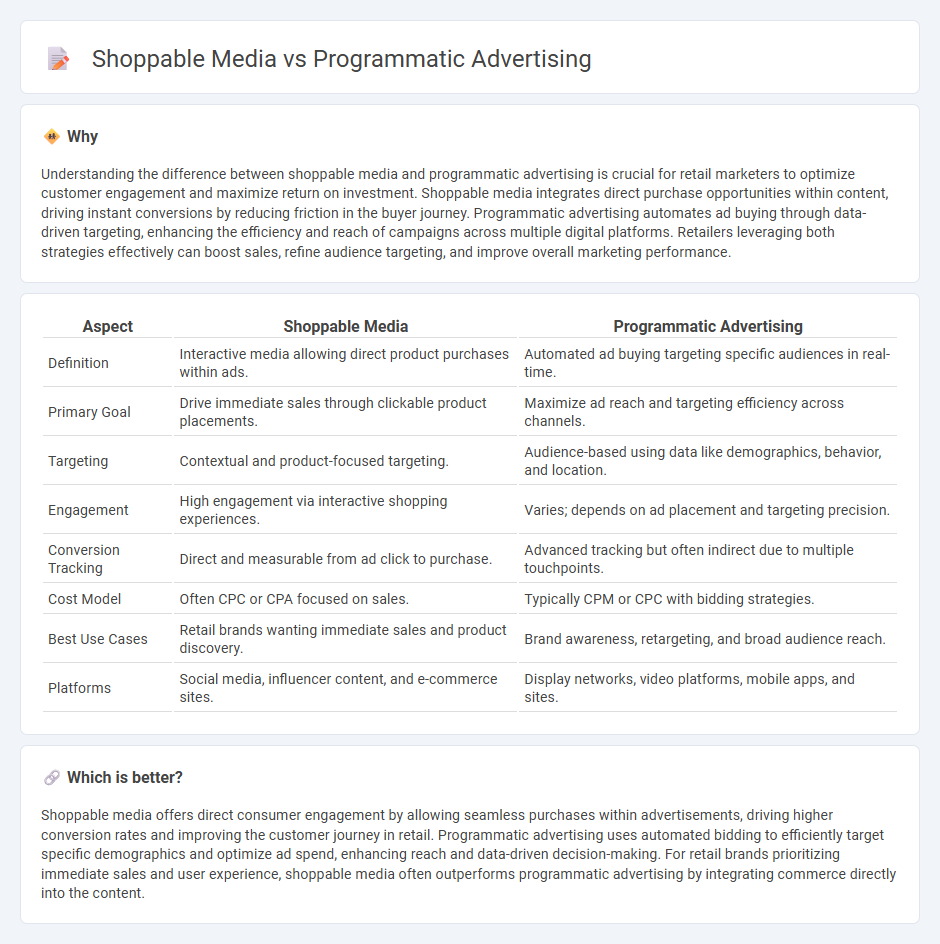
Shoppable media integrates interactive shopping elements directly within digital content, enabling consumers to make purchases seamlessly. Programmatic advertising uses automated technology to buy and optimize ad placements in real-time, targeting specific audiences with precision. Explore how these strategies transform retail marketing and drive sales growth.
Why it is important
Understanding the difference between shoppable media and programmatic advertising is crucial for retail marketers to optimize customer engagement and maximize return on investment. Shoppable media integrates direct purchase opportunities within content, driving instant conversions by reducing friction in the buyer journey. Programmatic advertising automates ad buying through data-driven targeting, enhancing the efficiency and reach of campaigns across multiple digital platforms. Retailers leveraging both strategies effectively can boost sales, refine audience targeting, and improve overall marketing performance.
Comparison Table
| Aspect | Shoppable Media | Programmatic Advertising |
|---|---|---|
| Definition | Interactive media allowing direct product purchases within ads. | Automated ad buying targeting specific audiences in real-time. |
| Primary Goal | Drive immediate sales through clickable product placements. | Maximize ad reach and targeting efficiency across channels. |
| Targeting | Contextual and product-focused targeting. | Audience-based using data like demographics, behavior, and location. |
| Engagement | High engagement via interactive shopping experiences. | Varies; depends on ad placement and targeting precision. |
| Conversion Tracking | Direct and measurable from ad click to purchase. | Advanced tracking but often indirect due to multiple touchpoints. |
| Cost Model | Often CPC or CPA focused on sales. | Typically CPM or CPC with bidding strategies. |
| Best Use Cases | Retail brands wanting immediate sales and product discovery. | Brand awareness, retargeting, and broad audience reach. |
| Platforms | Social media, influencer content, and e-commerce sites. | Display networks, video platforms, mobile apps, and sites. |
Which is better?
Shoppable media offers direct consumer engagement by allowing seamless purchases within advertisements, driving higher conversion rates and improving the customer journey in retail. Programmatic advertising uses automated bidding to efficiently target specific demographics and optimize ad spend, enhancing reach and data-driven decision-making. For retail brands prioritizing immediate sales and user experience, shoppable media often outperforms programmatic advertising by integrating commerce directly into the content.
Connection
Shoppable media integrates seamless purchase options directly within digital ads, enhancing customer engagement and conversion rates through interactive content. Programmatic advertising uses automated, data-driven approaches to target precise audiences, optimizing the delivery of shoppable media for maximum impact. This connection leverages real-time data to personalize ads, driving higher sales and improving retail marketing efficiency.
Key Terms
Real-time Bidding (RTB)
Real-time bidding (RTB) in programmatic advertising enables automated, instantaneous auctions for ad inventory, optimizing ad placements based on user data for precise targeting. Shoppable media integrates RTB to deliver interactive ads that allow consumers to purchase products directly within the ad experience, enhancing engagement and conversion rates. Discover how RTB transforms both programmatic advertising and shoppable media to maximize marketing efficiency and sales impact.
Interactive Content
Programmatic advertising leverages automated technology to deliver targeted ads in real-time, enhancing efficiency and audience reach, while shoppable media integrates interactive content that allows consumers to make purchases directly within the ad experience. Interactive content in shoppable media, such as clickable videos and augmented reality, drives higher engagement and conversion rates by simplifying the buyer journey. Explore more about how interactive content transforms digital marketing strategies and boosts ROI.
Conversion Attribution
Conversion attribution in programmatic advertising relies on real-time bidding data and algorithmic models to assign credit across multiple touchpoints, often emphasizing impressions and clicks in dynamic ad placements. Shoppable media enhances attribution accuracy by directly linking product interactions within content to purchases, providing clear and immediate consumer intent signals. Explore how integrating these approaches can optimize your marketing ROI and improve conversion tracking insights.
Source and External Links
What Is Programmatic Advertising? How Does It Work? - Programmatic advertising automates the buying and selling of ad spaces using technology and algorithms, allowing ads to be precisely targeted to the right audience at the right time without manual negotiations.
What Is Programmatic Advertising? How Does It Work? - Publift - This method uses AI and machine learning to automate real-time ad inventory sales, enabling advertisers to reach target audiences efficiently through demand-side platforms and data management platforms.
Programmatic Advertising Explained [as Humanly as Possible] - Programmatic advertising includes various formats such as display, video, native, connected TV, and digital out-of-home ads, allowing marketers to run highly targeted and cross-platform digital campaigns efficiently.
 dowidth.com
dowidth.com